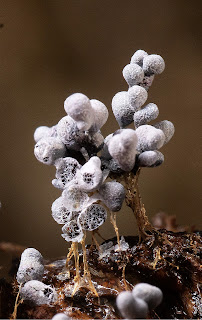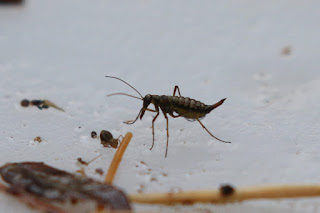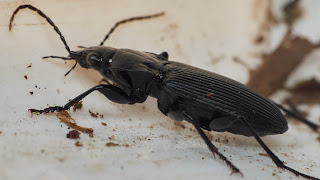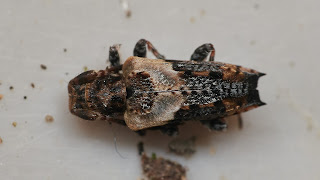Saturday 1st January 2022, Bury Ditches
Our second New Year’s Day walk took place at Bury Ditches. We met in the sizeable car park just in time as it was quite full, but with just enough room to squeeze us in.
After 256 Happy New Years to each other (we were seventeen in number) we set off along the forest track to the south of the hill fort.
As we approached the first bend the column had become quite strung out so a halt was called whilst the tail caught up.
What had delayed the back markers?
An Orange ladybird.
 |
| Photograph: Maria Justamond |
This process was repeated when we came to the first major junction of paths.
On setting off again the “leader” (i.e. me, as I had the map with the proposed route) found himself in the middle of the pack. And as I was busy being social with my walking buddy at that time I failed to notice the path on the right that the route suggested we took.
The track, which until that point had been fairly level, started to go down.
So what?
Then it took a gentle but considerable turn to the right.
The leader became concerned and on consulting his map found that we had overshot the right turn by a good distance.
And if we had not missed the turning we would not have seen this Bronze shieldbug!
 |
| Photograph: Maria Justamond |
A committee meeting was held and Plan B hatched. We would continue until we came to a path on the right which would take us to the path Plan A had us on.
We walked and talked on.
On arrival at the “Plan B path on the right” a quick scouting mission showed thatit was unsuitable for some of the group.
Another committee meeting was held and Plan C hatched. We would return to the turning onto the path Plan A suggested we took.
Pause to take in the view lent a certain mystery in the murky light.
 |
| Photograph: Maria Justamond |
We walked and talked as we made our way back around the bend and up the hill.
This time we found the “missed” turning BUT time was getting on and stomachs were rumbling.
A further committee meeting was held and Plan D hatched. We would ignore to the turning onto the path Plan A suggested and take the quickest route to the Hill Fort.
And that is what we did.
A broom psyllid, Arytaina genistae was found on the way.
 |
| Photograph: Maria Justamond |
The Hill Fort is quite exposed and, although it was very warm for the time of the year, the strong wind made it feel much cooler.
A sheltered spot was sought for lunch.
 |
| Photograph: Catherine Wellings |
The best shelter we could find was between two of the ramparts.
 |
| Photograph: Stephen Mitchell |
After a leisurely lunch we made our way to the toposcope to admire the view which was magnificent.
 |
| Photograph: Catherine Wellings |
Here we had a surprise when one of the group announced that he had built this structure 40 years ago.
This reunion prompted our toposcope builder to remember an earlier occasion when he had returned to see his work which had inspired him to prose:
[About 30 years ago, over two or three days, I built the small round stone cairn on the top of Bury Ditches, which holds the stainless steel topograph with direction markers.Someone has since attacked it with an axe or similar and I imagined that maybe those dents had come from the other side!]
WORN THIN
On the top, the fabric of time is worn thin, tattered and tugged by the wind. There are glimpses of a silver tongued story teller who holds a dented disc of stainless steel. A modern doorway on which our iron aged, gold torqued, proud walking ancestor is beating out a greeting. Or a warning, calling us to account. The gateways still defend and welcome. Pulsing with the ins and outs of the earth dragon's breath. War dogs patrol.Like soil and stones slumping down the banks the stories settle deep in the ditches. Still, children hide here, lying in soft turf safe from the obvious. Free to reach back and forward through the years. In dense, dizzying, silence, the tales are waiting to be told.The jets came up the valley. Two of them, too low. On a level with me. I held them as they turned. Wing tips joining heaven to earth. Moving around me, around the hill, screaming out their metal madness. Then they were gone leaving only the sound of a steel circle etched in the sky and the silence rolling back.Whether then or now, the gorse is still a sweet, bright yellow and thyme and wood sage share their scents down the years. Dry, dead grasses silhouette against the westering sky. The wind whispers its love for all. Down the years the hand is held out in kinship. Soaring high the buzzard holds the line.
Rob Rowe
We left the toposcope and made our way by the most direct route back to our transport (spotting a Larch ladybird en route) and returned home.
 |
| Photograph: Maria Justamond |
Wednesday 5th January 2022, Heath Farm, Dudmaston
Such a beautiful day to greet the New Year
Such a cloudless sky, so bright and so clear.
With nets at the ready we walk through the woods
Shaking the bushes and looking for bugs.
 |
| Photograph: Stephen Mitchell |
Perhaps a spider will fall in the tray,
Hurrying, scurrying and dashing away.
Posing for photographs, patient until
They return to the pine trees there to await
The warmth of the spring when they will awake.
 |
| Cream-streaked ladybirds - Photograph: David Williams |
 |
| Rhyzobius litura (dark form) - Photograph: David Williams |
A jingling sound through the trees I hear,
With bells on his collar a large dog appears.
With a flick of his tail and a twitch of his nose
And a smile on his face, onward he goes.
Despite the bright sun the snow and ice lingers
Biting our toes and numbing our fingers.
Time for hot chocolate to drink with a sigh
And gaze at the rainbow arc in the sky.
Down came a shower of misty, cold rain,
We stay under cover then venture again.
Trek up the hill impatient to see
If the patches of moss hold the tiny snow flea
Then a cheer burst forth and excitement spills,
Jim’s trusty vac all our hopes have fulfilled.
Where nestled remotely, a small cottage stood.
Hidden from sight by the shadowy trees
A fairy tale cottage held in fast-freeze.
Did a woodsman dwell there, sadly alone?
Or a witch with a cauldron stirred with a bone?
We escape to a meadow bathed in sunlight,
Sandy and rough we climb to the heights
Where badgers have tunnelled down under the hill
And sleep through the daytime, silent and still.
Happily chatting with nothing to show
Except all of these memories stored in our minds
Of Dudmaston Heath amongst the tall pines.
My thanks to Margaret Mitchell for providing these lines.
Wednesday 12th January 2022, Callow Hill
It was a gloriously sunny day as we approach Callow Hill. However as we neared the parking spot it was clear that we would not see the sun again for some time as the folly of visiting a steeply sloping north facing site dawned on us. Hey ho!
It was bitterly cold as we set off in the shade of the hill towering above us with Flounders’ Folly silhouetted on the ridge line by the bright sun on the other side.
Did the cold deter us?
Well, we hesitated a bit maybe, before getting on with the business of the day – talking, keeping warm etc. and looking for any invertebrates that poked its head up out of its refuge from the winter weather.
A short walk up the forestry track brought us to a clearing. This was searched with vigour, more in the need to keep warm than in the hope of finding anything, but we were rewarded with a few overwintering ladybirds together with several tiny flies.
However the flies included one that was new to Shropshire, a Chloropidae - Lasiosina herpina. (Sorry I do not have a photograph.) An excellent find.
Tempting as it was not to tackle the hill, we did.
Unfortunately the path was extremely slippery but with careful navigation we progressed steadily upwards without incident stopping at likely looking patches of Polytrichum moss to check for snow fleas.
Alas, no snow fleas were found on this trip.
Having reached the top of the sloping path we made our way along the ridge line to the tower.
We were in the sun at last!!
And it was relatively warm, but I stress ”relatively”.
However, it was ideal weather for soaring camera.
The tower and the view to the north east:
 |
Photograph: Bob Kemp |
And the view to the south west.
 |
| Photograph: Bob Kemp |
Lunch was taken taking advantage of the small picnic area, bench and other suitable objects in the clearing that surrounded it.
A search of the vegetation in the clearing yielded the larva of an Angle shades moth.
 |
| Photograph: David Williams |
Two Red kites passed by in the valley below, then three Buzzards soared from the valley and in the distance a flock of Lapwing flew low over the horizon.
The tower itself proved to be a refuge for ladybirds, including two forms of the 2-spot ladybird, and flies as they benefited from the warmth of the sun stored in the stones.
 |
| 2-spot ladybird f. typica - Photograph: David Williams |
 |
| 2-spot ladybird f. quadrimaculata - Photograph: David Williams |
 |
| Calliphora vicina - Photograph: John Martin |
And as the sun progressed around the tower it reached the most northerly facing wall, its rays binging the stones of the tower wall into relief..
 |
| Photograph: Bob Kemp |
After all this excitement it was time to make our way back down the slope to the cars.
Wednesday 19th January 2022, Eardington Quarry
Eardington Quarry is a former sand and gravel quarry. Quarrying at the site ceased in the mid-1990s after which it was used as a ready-mixed concrete plant until 2010.
The site is now managed as a nature reserve by Shropshire County Council in partnership with Friends of Eardington Nature Reserve who are a local community and volunteer group.
The area of most interest is the central area which has exposed sand and gravel and is a valuable habitat for solitary bees and other invertebrates. Unfortunately preventing scrub encroachment in this area is a continual battle.
The central area is surrounded by grassland and woodland, It also contains a couple of pools.
We arrived at the site in rain.
But the weather forecast stated that kit would cease at 10.30am – and it did!!
We then had periods of sunshine and cloud. However, there was a bitingly cold breeze so the day was spent being very cold in the wind or too warm in the sun when sheltered from the wind. What tricky conditions we have to put up with! But it was JANUARY.
I am sad to report that yet again we failed to find any snow fleas.
Never mind, we were more than compensated by finding a leatherbug that has not been recorded in the county before – Fallen’s leatherbug, Arenocoris fallenii.
 |
| Photograph: David Williams |
According to the British Bugs website (www.britishbugs.org.uk) their usual habitat is coastal sand dunes between Norfolk and south Wales and also the East Anglian brecks. But in recent years it has been found increasingly in gravel pits and sandy habitats. So, Eardington Quarry seems an ideal home for this bug.
During the day we moved between the central area, the woodland and grassland until a heavy shower of rain drove us back to the cars. Here are some of the other highlights:
Galls on a Ganoderma fungus caused by the Yellow flat-footed fly, Agathomyia wankowiczii;
 |
| Photograph: Nigel Jones |
A ground beetle, Pterostichus niger;
 |
| Photograph: David Williams |
A springtail, Dicyrtomina saundersi;
An inconspicuous ladybird, Rhyzobius lophanthe;
 |
| Photograph: David Williams |
Wednesday 26th January 2022, Harton Hollow Nature Reserve
At our third attempt we finally made it to Harton Hollow. Weather and preparations for Christmas had prevented earlier attempts. But we finally made it! An were greeted on a chilly day by a glorious blue sky and full sun. Excellent condition for a photograph of the site from the aerial tripod.
 |
| Photograph: Bob Kemp |
As this has been rather a long report I will keep this part brief although I will not skimp on the photographs which, of course, provide the main interest!
We arrived; walked about looking for things of interest in the vegetation; found things of interest; identified many of them; looked at but failed to identify some others; and returned home.
What an excellent way to spend a winter’s day.
And now the important bit – the photographs.
A slime mould, not yet identified. What you can see in the photograph are the fruiting bodies.
 |
| Photograph: Bob Kemp |
A weevil, Apion cruentatum.
 |
| Photograph: Emm Cane-Honeysett |
Thrips – found on the trunk of a tree. Research by the photographer has revealed that they may be a member of the genus Hoplothrips.
 |
| Photograph: David Williams |
And what may be their eggs.
 |
| Photograph: David Williams |
Another organism, as yet unidentified, a fungus.
 |
| Photograph: Bob Kemp |
Limacus maculatus, Irish yellow slug.
 |
| Photograph: Bob Kemp |
A overwintering Hornet tucked up in the hole in a dead branch.
And finally the welcome return of the Wednesday Weevil of the Week. This week it is Ischnopterapion virens.
My thanks to Forestry England, Shropshire Wildlife Trust and Shropshire County Council for giving us permission to do what we enjoy doing and to the photographers for their fabulous images. My gratitude to the additional contributors of text for the report.
Where’s Wally
I am not aware of anyone who found Wally in the picture I posted in the previous report. Sorry it was so difficult – blame the jigsaw makers not me!
Here he is circled in yellow.
Keep well.







































